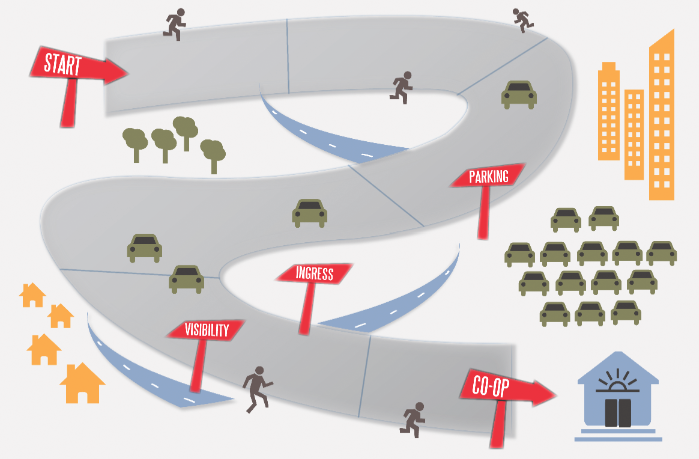Finding the Right Site for Your Co-op

When you are evaluating a natural food co-op store location, there are a number of characteristics that can add to, or detract from, the store’s ability to generate sales. This is the second in a series of articles oriented toward discussing the types of issues to be considered in locating a natural food co-op store. Location characteristics were discussion in Part 1: “Location, Location, Location,” CG #154, May–June 2011.
The second set of issues in locating a store, site characteristics, includes such things as visibility, ingress/egress, and parking. A forthcoming article will discuss facility characteristics.
Visibility is important for a natural food co-op store—especially if the store is located in a high-growth market area. Consider these observations. First, an average of about 16 percent of the American population changes residences (i.e., moves) in any given year. Second, it has been found that, when a household moves to a new location, it normally selects its regular food store within the first three to four weeks of establishing the new residence.
Taking these two observations together, it’s evident that visibility is an important element in a store’s ability to capture its share of the potential “new business” in town. In addition, according to numerous consumer research studies, the vast majority of consumers first become aware of a new store by driving or walking by it. As a result, visibility of the store from a major thoroughfare is tremendously helpful in attracting and building a store’s customer and sales base. This places co-ops that are located on minor/secondary roads (such as Hendersonville Community Co-op in Hendersonville, N.C., and Good Food Store Co-op in Rochester, Minn.) at a significant disadvantage in terms of raising consumer awareness levels and realizing more of the available sales potential within their market areas.
There are several aspects of visibility that should be considered. The store should be seen from as many directions as possible, and from as far away as possible, in order to enhance the store’s chances of being shopped. While such things as pylon or monument signs along the main frontage road(s) or well-designed, well-lighted storefront signage can enhance a store’s visibility, such things as adjacent structures, trees, or other signage can impede a store’s visibility. Whatever the case, it’s vital to recognize the importance of a store’s visibility in gaining new customers.
Ingress/egress refers to the ease or difficulty with which shoppers can enter or exit a store’s parking area from the streets. To the extent that it’s relatively easy for a shopper to enter or leave a food store parking area, it adds to the level of convenience being offered. Things to consider when evaluating a food store’s ingress/egress include speed limits along frontage streets, controlled left-turn lanes, curb cuts, deceleration lanes, and traffic signals. When these favor easy entry or exit from the parking area, they can add to the store’s level of convenience to its shoppers.
Parking is the third element of site characteristics that is critically important to a natural food co-op store. In considering parking, both configuration and capacity need to be addressed. In terms of configuration, numerous parking studies have shown that the most effective parking for a retail food store is within a 300–350-foot radius of the front door of the store. Parking lot drive lanes need to be perpendicular, rather than parallel, to the storefront. Also, the most desirable parking exists within sight of the store’s entry/exit doors.
With respect to parking capacity, it must be remembered that, in virtually all instances (except for urban sites in extremely dense areas), most food shoppers arrive at the store in private automobiles. There are several rules of thumb in calculating the amount of parking that is needed. In general, the more suburban the food store location, the higher should be the store’s parking capacity (expressed in cars per 1,000 square feet of food store). That is, in densely populated urban areas, food store parking should be provided for at least four cars for every 1,000 square feet of food store (gross area), while in suburban areas, where nearly all shoppers drive to the store, as many as eight cars per 1,000 square feet of food store may be necessary. The suburban nature of Valley Natural Foods in Burnsville, Minn., for instance, resulted in co-op management opting for more parking capacity than was required by the city. Management correctly understood the high parking demands of their customer base and the importance of meeting these demands in order to compete more effectively with the other food stores in their market area and to achieve their full sales potential.
A lack of sufficient parking capacity will no doubt constrain a co-op’s sales growth. When this occurs, some co-ops (such as People’s Food Co-op in La Crosse, Wis.) attempt to mitigate the problem by expanding store hours, leasing parking spaces on adjacent property, and requiring staff to park off-site. Many other co-ops patiently await the possibility of acquiring adjacent property in order to expand their store’s parking lot. Olympia Food Co-op in Olympia, Wash., was fortunate to have the ability to acquire property adjacent to its Pacific Avenue store, with the intention of expanding the store’s parking lot, after recognizing that limitations in parking capacity were impeding its ability to realize more of the available sales potential within its market area.
In summary, just as certain location characteristics (population density, target demographics, lifestyle characteristics, trade area accessibility, and retail synergy) play an important role in selecting an appropriate natural food co-op store location, so too do site characteristics such as visibility, ingress/egress, and parking. To the extent that there are limitations in these site characteristics, food store sales may suffer as a result. ■







